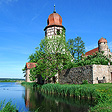LUTHER CITY WITTENBERG LUTHERSTADT
Martin Luther and the Church Doors of Wittenberg
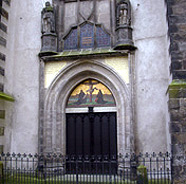 They
might be called the church doors that changed the world. I refer to
the doors of the All Saints
Castle
Church of then simply Wittenberg, Germany where
in 1517 local monk and scholar Martin Luther nailed his thesis of 95
reformations to Catholic orthodoxy, objecting to the selling
of “indulgences”,
beginning the road to Protestantism and four centuries of social
and political upheaval. The doors are no longer the original wooden ones
which burned in a fire in the 1700s but now bronze, aged by a
dark patina with the Latin text of Luther’s theses molded into
them, (very often with Luther tour groups standing in front of them).
Wittenberg was Luther’s
hometown on the Elbe River, so associated with him and his turning
the religious world on its head that it is now officially Wittenberg-Lutherstadt
(Luther
City Wittenberg).
They
might be called the church doors that changed the world. I refer to
the doors of the All Saints
Castle
Church of then simply Wittenberg, Germany where
in 1517 local monk and scholar Martin Luther nailed his thesis of 95
reformations to Catholic orthodoxy, objecting to the selling
of “indulgences”,
beginning the road to Protestantism and four centuries of social
and political upheaval. The doors are no longer the original wooden ones
which burned in a fire in the 1700s but now bronze, aged by a
dark patina with the Latin text of Luther’s theses molded into
them, (very often with Luther tour groups standing in front of them).
Wittenberg was Luther’s
hometown on the Elbe River, so associated with him and his turning
the religious world on its head that it is now officially Wittenberg-Lutherstadt
(Luther
City Wittenberg).
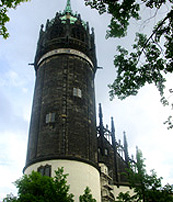 The
city of Wittenberg was an important political center at the end of the
15th Century as the seat of the Elector of Saxony and
the site of the University of Wittenberg where Martin Luther was a professor.
The Wittenberg All Saints Schlosskirch or Castle Church is rather foreboding
in presence as befits its importance in history, its bell tower
set with its own dark crown. Luther himself is buried within the church
a
few paces in front of the ornate
carved pulpit.
His body lies floors below, but a marker within
the church
denotes
his place, across the nave is the marker for his wife, Katharina. Where
Catholic shrines are adorned with pomp and filigree this is a most simple
marker for such an important figure, but fitting Luther’s
more direct and less ornate view of worship.
The
city of Wittenberg was an important political center at the end of the
15th Century as the seat of the Elector of Saxony and
the site of the University of Wittenberg where Martin Luther was a professor.
The Wittenberg All Saints Schlosskirch or Castle Church is rather foreboding
in presence as befits its importance in history, its bell tower
set with its own dark crown. Luther himself is buried within the church
a
few paces in front of the ornate
carved pulpit.
His body lies floors below, but a marker within
the church
denotes
his place, across the nave is the marker for his wife, Katharina. Where
Catholic shrines are adorned with pomp and filigree this is a most simple
marker for such an important figure, but fitting Luther’s
more direct and less ornate view of worship.
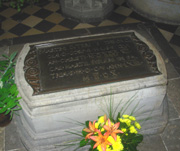 The
town of Lutherstadt-Wittenberg is a good deal brighter and more pleasant
than the heavy weight of its most famous citizen would
suggest, represented
by his stature in the town square, at least when its not raining. A popular
stop on any tour of Luther sites for history tourists
or religious pilgrims alike. The old town is laid out along two main
pedestrian
streets of half-wood 16th Century and older buildings and shops with
obligatory
pictures of Luther in the windows. Parking lots are available of traffic
bypass streets on either side of the old town which survives in much
of its historic form because it was mostly spared bombing by the allies
in WWII due to its religious history importance
- except for an airplane factory outside of town.
The
town of Lutherstadt-Wittenberg is a good deal brighter and more pleasant
than the heavy weight of its most famous citizen would
suggest, represented
by his stature in the town square, at least when its not raining. A popular
stop on any tour of Luther sites for history tourists
or religious pilgrims alike. The old town is laid out along two main
pedestrian
streets of half-wood 16th Century and older buildings and shops with
obligatory
pictures of Luther in the windows. Parking lots are available of traffic
bypass streets on either side of the old town which survives in much
of its historic form because it was mostly spared bombing by the allies
in WWII due to its religious history importance
- except for an airplane factory outside of town.
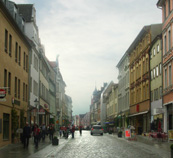 At the far end of the
historic old town from
the All Saints Schloss Church is Luther’s House and Museum (Lutherhalle)
located in the former Augustinian monastery where Luther came to his
view of reaching heaven “by faith alone”. The monastery was
dissolved when Luther’s reformation replaced Catholicism in northern
Germany and part of it was give to him as a home. The house is meticulously
preserved with Luther’s room, a grand hall and lecture hall where
Luther taught students, the family table where Luther and with wife Katharina
held Table Talks with his students. There is a collection of art and
other Lutheran personal artifacts.
At the far end of the
historic old town from
the All Saints Schloss Church is Luther’s House and Museum (Lutherhalle)
located in the former Augustinian monastery where Luther came to his
view of reaching heaven “by faith alone”. The monastery was
dissolved when Luther’s reformation replaced Catholicism in northern
Germany and part of it was give to him as a home. The house is meticulously
preserved with Luther’s room, a grand hall and lecture hall where
Luther taught students, the family table where Luther and with wife Katharina
held Table Talks with his students. There is a collection of art and
other Lutheran personal artifacts.
A short distance outside the house
is the Luther Oak where the outcast cleric burned the Papal Bull of Excommunication
in 1520 and nearby is the St. Mary Parish Church where Luther and Katharine
were married and where Luther preached. Here can be found the painting
of The Commandments by Cranach the Elder, a one-time mayor of Wittenberg,
with the faces of Luther and his followers at the Lord’s Supper.
Also in Lutherstadt-Wittenberg is the grand three story Renaissance era
Melanchthon House built in 1536, home of Martin Luther's right-hand man
and one of the Reformations early great scholars, Phillip Melanchthon.
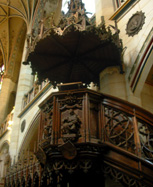 Lutherstadt Wittenberg is located in Sachsen-Anhalt in the one-time East
Germany, about half-way between Leipzig and Berlin, under an hour from
either city by car, fifteen
minutes
from
the
A9 autobahn near Dessau.
There are a number of hotels within the old town including a Best Western Stadtpalais Wittenberg
Lutherstadt Wittenberg is located in Sachsen-Anhalt in the one-time East
Germany, about half-way between Leipzig and Berlin, under an hour from
either city by car, fifteen
minutes
from
the
A9 autobahn near Dessau.
There are a number of hotels within the old town including a Best Western Stadtpalais Wittenberg and
a very nice modern youth
hostel directly behind the castle church. For Luther
pilgrims, Wittenberg is a key stop on a route
that would include Worms,
Heidelberg, Wartburg Castle at Eisenach (see Luther
at Wartburg Castle),
Lutherstadt
Eisleben, Dresden (see Frauenkirche
Dresden) and Erfurt. © Bargain
Travel Europe
Find best hotel and vacation deals in Wittenberg
Lutherstadt
Web Info
Saxony-Anhalt
Tourism
These articles are copyrighted and the sole property of Bargain Travel Europe and WLPV, LLC. and may not be copied or reprinted without permission.
See Also:
SAXONY CULTURE HIGHLIGHTS 2016-2017
500th ANNIVERSARY MARTIN LUTHER - WARTBURG CASTLE
WALKING & CYCLING
THE LUTHER ROUTE
WORMS
CATHEDRAL AND MARTIN LUTHER
GERMANY
CASTLE ROAD
HEIDELBERG
CASTLE
GROSSMÜNSTER
- SWISS REFORMATION

